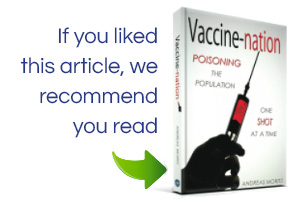By: Dr. Mercola (2012)
Source: Mercola.com
Faster than a speeding bullet, closer to the speed of sound―in the very near future your next vaccine may be injected into your body quicker than the blink of your eye.
And it’ll be nearly painless, if scientists at Massachusetts Institute of Technology (MIT) are right about an invention they unveiled recently.
Drugs Administered Via High-Pressured Jet
The mechanism consists of a tiny, high-pressured jet that eliminates needles and delivers drugs directly into the skin. Traveling at around 340 meters per second, the device works similarly to a mosquito’s proboscis. If it works the way researchers plan, it may very well spell the end of needles used for injections.
So far they’ve been able to use it to deliver drugs through both the retina in the eye and the middle and inner ear, and they’re working on a similar device that takes powdered drugs and makes them liquid-like when they’re injected into the skin.
For people who loathe needles, or those who use injectable drugs frequently, the device certainly shows promise – but this is far from the first time researchers have come up with a needle-free injection system.
Every year, Americans receive 16 billion injections of various medications and vaccines, and companies have long been clamoring to devise a new device that could eventually replace needles altogether.
Needle-Free Injections Have Been Around Since the 1800s
The first “jet injection” systems reportedly came about in the 1860s, and were used to deliver liquid medications. Later, in the 1950s, the U.S. military used gas-powered “jet guns” to vaccinate masses of troops. Notorious for problems, such as skin wounds and contamination with blood-borne pathogens between patients, the devices were eventually banned in 1997.
Newer needle-free systems are smaller than their predecessors and could be available for personal use, unlike the jet injection systems of the past, which were largely used for mass vaccination programs. But don’t think this isn’t the plan for the newer models as well.
Needle Fears Often Cited as a Primary Reason for Vaccination “Non-Compliance”
Writing in the journal Vaccine, researchers noted:
“Needle fears are a documented barrier to immunization in children and adults … Needle fear was present in 2/3 of children and 1/4 of adults. Needle fear was the primary reason for immunization non-compliance for 7% and 8% of parents and children, respectively.”
Government regulators and drug companies alike know they can probably get more people vaccinated if they offer needle-free vaccines, which is why vaccines that are administered nasally are sometimes offered as an alternative. In October 2011, the U.S. Food and Drug Administration (FDA) gave marketing clearance to one needle-free product called the PharmaJet Needle-Free Injection System. The company promptly rolled out production and partnered with Kroger Pharmacy to offer needle-free flu shots during the 2011/2012 flu season. Bioject, another producer of a needle-free injector, also planned to offer needle-free flu shots last year at Publix and Fred Meyer stores in several U.S. states.
Shortly thereafter, however, the FDA warned doctors, nurses and pharmacists not to use the devices for flu shots. Even though they had received FDA clearance, the FDA noted that vaccines are currently labeled with specific instructions on how they should be administered, and there are currently no flu vaccines approved for administration by jet injector.But it’s not likely to stay that way for long.
A Drug is Still a Drug, No Matter How It’s Administered
Needle-free technology is a boon for those rare cases when someone is terrified of needles but needs an injectable drug … but when deciding on a vaccination or a medication it’s important to evaluate not only the route by which it is administered, but also the drug itself.
Public health officials have long insisted that vaccines are the best way to protect the public health. As a result, the number of doses of vaccines included in the childhood vaccination schedule has tripled over the past 30 years, from 23 doses of seven different vaccines in 1980 to 69 doses of 16 different vaccines in 2010.
However, alongside the rise in administered vaccines, we’ve also seen a significant rise in children with chronic disease and disabilities. For whatever reason, our kids are getting sicker. Infant mortality has also risen. In 1960, America ranked 12th in infant mortality among all nations of the world. By 2005, we ranked 30th. Furthermore, more full-term babies die before their first birthday in the US than in most European countries, and the US gives its infants more vaccines than any other country in the world.
So, could it all be a coincidence?
The truth is, we don’t know.
No one has formally and independently studied the health outcomes of vaccinated versus unvaccinated children, and this is something that needs to be done not just for each individual vaccine, but also for multiple vaccine combinations.
It’s not only vaccines that are the problem. If you’re an “average” 65-year-old (or older) adult living in the United States, you fill more than 31 prescriptions per year. Those aged 19 to 64 take more than 11 prescription drugs per year, while even children take an average of 4, according to statistics from the Kaiser Health Foundation. In the vast majority of cases, drugs are overused and over prescribed, even in cases where the risks far exceed any potential benefits.
So one of the most important questions to ask yourself and your health care practitioner before deciding to take any drug is:
Do I really need it?
Oftentimes you’ll find the answer is no. So I hope that you will view drugs as a last resort instead of a first choice, and will instead embrace the massive shift in thinking to realize that your body can often heal itself if you give it the proper “tools.”
To view the original article click here.
To reprint this article, visit the source website for reprinting guidelines.






